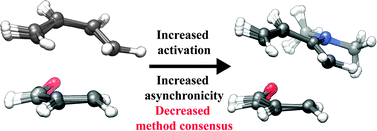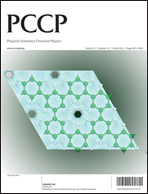On the method-dependence of transition state asynchronicity in Diels–Alder reactions†
Abstract
This work discusses the dependence of transition state geometries on the choice of quantum chemical optimization method for the extensively studied Diels–Alder reaction. Rather significant differences are observed between post-Hartree–Fock methods and (hybrid) density functional theory, where the latter predicts larger asynchronicities. The results show that the low MP2 asynchronicity observed is likely artificial. Still, there are significant discrepancies between hybrid and pure density functionals. The role of the exchange functional seems to be most prominent in less activated reacting systems, while the importance of the correlation functional seems to increase as they become more activated by, e.g., an electron-donating group on the diene. To correct the dubious MP2 geometries, we employed the SCS-MP2 protocol for transition state optimization, which leads to significantly better results with respect to CCSD/6-31+G(d) level calculations. We conclude that in order for hybrid functionals to give descriptions consistent with the sample post-Hartree–Fock methods, a balanced combination of both Hartree–Fock exchange (with a couple of exceptions) and a well-behaved correlation functional is required. Given that the benchmark CCSD/6-31+G(d) geometries are sufficient representations, the best geometries were obtained using ωB97X(D), B2PLYP(D) and M06-2X.


 Please wait while we load your content...
Please wait while we load your content...